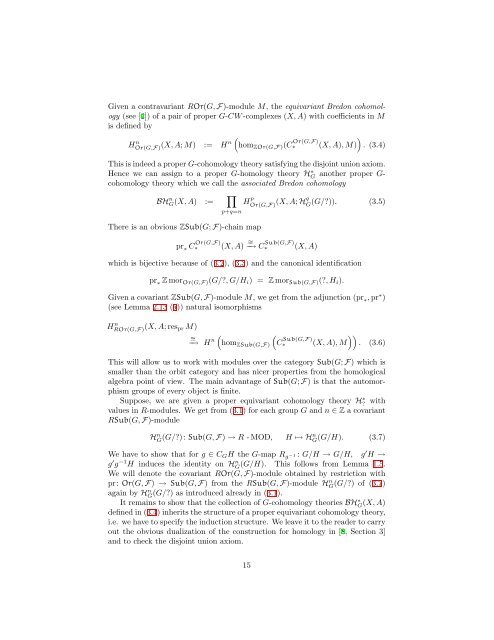Equivariant Cohomological Chern Characters
Equivariant Cohomological Chern Characters
Equivariant Cohomological Chern Characters
Create successful ePaper yourself
Turn your PDF publications into a flip-book with our unique Google optimized e-Paper software.
Given a contravariant ROr(G, F)-module M, the equivariant Bredon cohomology(see [2]) of a pair of proper G-CW -complexes (X, A) with coefficients in Mis defined by( )HOr(G,F) n (X, A; M) := Hn hom ZOr(G,F) (C∗ Or(G,F) (X, A), M) . (3.4)This is indeed a proper G-cohomology theory satisfying the disjoint union axiom.Hence we can assign to a proper G-homology theory HG ∗ another proper G-cohomology theory which we call the associated Bredon cohomology∏BHG(X, n A) := H p Or(G,F) (X, A; Hq G(G/?)). (3.5)p+q=nThere is an obvious ZSub(G; F)-chain mappr ∗ C∗Or(G,F) (X, A) −→ ∼= C∗ Sub(G,F) (X, A)which is bijective because of (3.2), (3.3) and the canonical identificationpr ∗ Z mor Or(G,F) (G/?, G/H i ) = Z mor Sub(G,F) (?, H i ).Given a covariant ZSub(G, F)-module M, we get from the adjunction (pr ∗ , pr ∗ )(see Lemma 2.13 (a)) natural isomorphismsHROr(G,F) n (X, A; res pr M)∼ ( ))=−→ H n hom ZSub(G,F)(C ∗Sub(G,F) (X, A), M . (3.6)This will allow us to work with modules over the category Sub(G; F) which issmaller than the orbit category and has nicer properties from the homologicalalgebra point of view. The main advantage of Sub(G; F) is that the automorphismgroups of every object is finite.Suppose, we are given a proper equivariant cohomology theory H?∗ withvalues in R-modules. We get from (3.1) for each group G and n ∈ Z a covariantRSub(G, F)-moduleHG n (G/?): Sub(G, F) → R - MOD, H ↦→ Hn G (G/H). (3.7)We have to show that for g ∈ C G H the G-map R g −1 : G/H → G/H, g ′ H →g ′ g −1 H induces the identity on HG n (G/H). This follows from Lemma 1.5.We will denote the covariant ROr(G, F)-module obtained by restriction withpr: Or(G, F) → Sub(G, F) from the RSub(G, F)-module HG n (G/?) of (3.7)again by HG n (G/?) as introduced already in (3.1).It remains to show that the collection of G-cohomology theories BHG ∗ (X, A)defined in (3.4) inherits the structure of a proper equivariant cohomology theory,i.e. we have to specify the induction structure. We leave it to the reader to carryout the obvious dualization of the construction for homology in [8, Section 3]and to check the disjoint union axiom.15
















